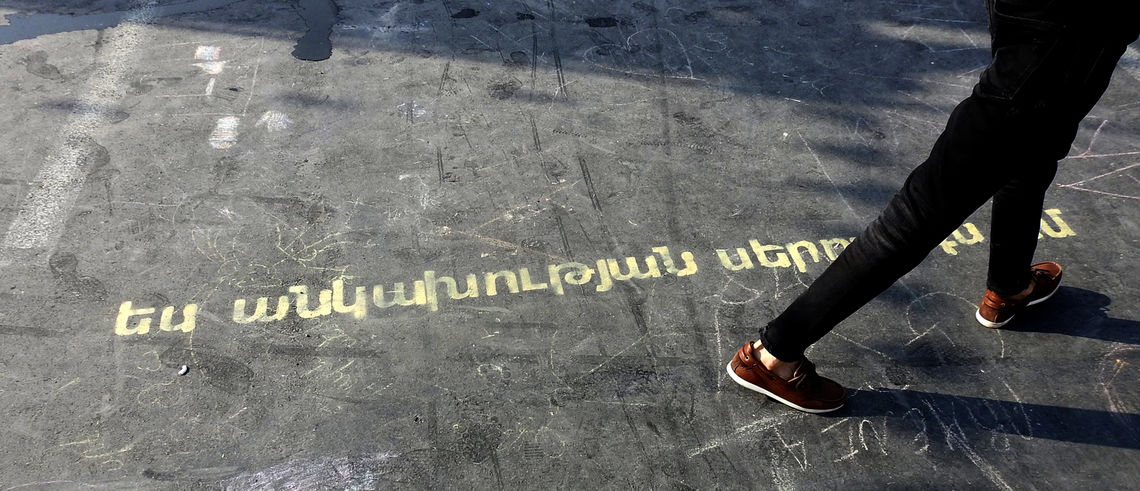Mon Sep 21 2020 · 6 min read
Yearning for Sovereignty: The Burden of Independence

By Nerses Kopalyan

Hundreds and thousands on the streets, with fists raised, symbolizing a singular maxim: Struggle.
The demand for independence and the Karabakh conundrum, inextricably entwined.
The nostalgia of 1918, beautiful yet suffocating.
Moscow blinked, and Yerevan made its move: the bittersweet burden of state-building.
Collective memory is an extraordinary phenomenon, as it transcends generations and imbues within a people an astonishing responsibility, the responsibility of defying history, of seeking a renaissance, and creating anew, a political reality. For the Armenian people, September 21, 1991 marked the realization of this new political reality: the independent Republic of Armenia.
The forces of history have always been too great for the Armenian people to conquer, but the will of the Armenian people have been even greater against the cruelness of history. Our collective memory does not so much glorify its history, but rather, glorifies our defiance of it. The constant and brutal struggle for a singular outcome: to survive, to simply exist. This survival, however, has only been tolerable, a tolerance shaped by subjugation, oppression, and injustice. Brutalized by the empires of history, denied agency, autonomy and self-determination, the modern history of the Armenian people has been one of subservience and helplessness: an agonizing trauma scarred into our collective consciousness. Yet it was this traumatized consciousness, driven by collective memory, that erupted into a massive political movement, one that challenged one of the most powerful states in the world, while at the same time taking up arms to defend all it holds sacred. The year 1991 is not simply the year that Armenia became independent; it is also the year that the Armenian people experienced a reality very much alien to us: sovereignty.
Accustomed to a way of life that was defined by authoritarianism and dependency, the intoxication of sovereignty puzzled the Armenian people, as it struggled to comprehend the responsibilities of a free society. Elated and empowered, it embraced the euphoria of independence, the aesthetics of a revived nationalism and the birth of a new age. However, even in this state of euphoria, in this new age, in this nascent free society, that singular maxim maintained itself: Struggle. The struggle for bread, the struggle for decency, the struggle for democracy, the very struggle to survive—that is, the struggle of sovereignty. Between war and perseverance, cold and hunger, the sword of fear and uncertainty hung over the Armenian people. The euphoria of independence had gone from an ethereal dream to a suffocating nightmare. The brutishness of cold reality pierced the delicate soul of Armenian society: sovereignty was a blessing and a curse. Not only did we not understand our sovereignty, we did not know what to do with it.
And so the years passed, and on every 21st of September we celebrated our independence, we celebrated our sovereignty, we celebrated not knowing what we were precisely celebrating. Our sovereignty had become unintelligible to us, it had become an abstraction that no longer resonated with the Armenian citizen, it was something beautiful that had now been seized and appropriated by the political elite. And therein lies our puzzlement: our state was independent, but not its people, our government was sovereign, but not its citizens. But there was, indeed, an awareness that never left our general will: we knew our sovereignty was ours, but only needed to find a way to exercise it. So the same maxim returned: Struggle. For this reason, while we celebrate the birth of the independent Armenian Republic, we are actually celebrating something else. In essence, we continue celebrating our defiance of history, our defiance of injustice, and our defiance of surrendering. Every September 21, Armenians celebrate their will-to-power, their indestructible will to Struggle.
An entire generation has been born since 1991. The very first generation, since medieval times, to have been raised in an independent Armenia. The first generation to have experienced birth in a free homeland. And this will be the generation that carries the burden of securing and fighting to maintain this freedom. Independence did not only create a new Armenia, but created a new Armenian, one that is neither Soviet nor Diasporan, a unique corollary of history whose Armenianness has no complimentary designation. It is neither Eastern or Western, but rather, an authentic byproduct of its intrinsic self. This Independence Generation, then, finds its identity intrinsically bound to the rebirth of Armenia. It is the dialectical fulfillment of the collective Armenian memory, the embodiment of a continuous Spirit that has nourished the Armenian soul, and by virtue of its historical singularity, the guardian of the only home that the global Armenian nation can call its own.
And so this generation now leads the Struggle. It mans the trenches and deters the enemy. It revolts against injustice and demands democracy. It shares the burden of democratization and commands accountability. It is this generation that struggles to fulfill the promises of 1991; it is this generation that struggles to correct the mistakes of the previous generations; it is this generation that struggles to reestablish the sovereignty that was attained after independence. This Independence Generation! The only Armenian generation born with sovereignty as an inherent right.
But September 21 is not only specific to Armenia, for over and beyond Armenia, it is dear to the millions of Armenians of the Diaspora. The dream of many, it is a victory for the Genocide generation and its offspring, a vindication of history, and a reification of a hope that had for nearly a century been a fleeting vision. For the Diaspora, the independence of Armenia was a glorious achievement, a triumph for a stateless nation that had for decades carried the burden of preserving Armenianness. But just as importantly, an independent Armenia became the home that many never knew they had, the one place in the world where being Armenian did not demand anything of them. 1991, then, became the year when the Diaspora began building a transnational bridge, only to be met halfway by the Republic of Armenia, a bridge that culturally, economically, and psychologically began to tie the Armenian nation together. The Struggle was now a unified and collective effort. And so as we celebrate Independence Day every year, we are, in essence, celebrating the weaving of this transnational bond, celebrating the strengthening of the fabric that ties the Armenian world together, and perhaps more importantly, celebrating the fact that a sovereign Armenia holds, in some way, a future for all of us. It is said that distance is a great promoter of admiration. As we slowly close this distance, the Diaspora’s admiration of its homeland jubilantly becomes a reality. September 21, 1991 is how this all became possible.
Independent Armenia has made one thing clear: it prefers sovereignty with danger over peace with servitude. The birth of the Armenian Republic was accompanied with the sword of Damocles, yet Armenia has continued to persevere and grow even under such looming danger. To quote Kostan Zarian, “Being an Armenian is a merciless task and a heroic enterprise. It is a commandment, a mission, and a destiny that history has imposed on us from the depths of centuries. We are the shock troops of the struggle between light and darkness… And we are charged with an awesome responsibility.” This responsibility, in no uncertain terms, is the preservation of our current sovereignty and independence. Our Independence Day, then, is a testimony to our resilience, a homage to our fighting spirit, an inner strength we draw from our historical ethos, and a will to Struggle that borders the fanatical. There is a crude beauty to independent Armenia, a certain grandeur that is rugged, yet elegant: it is Armenian history waking up from a long nightmare, realizing that it can breathe again.


